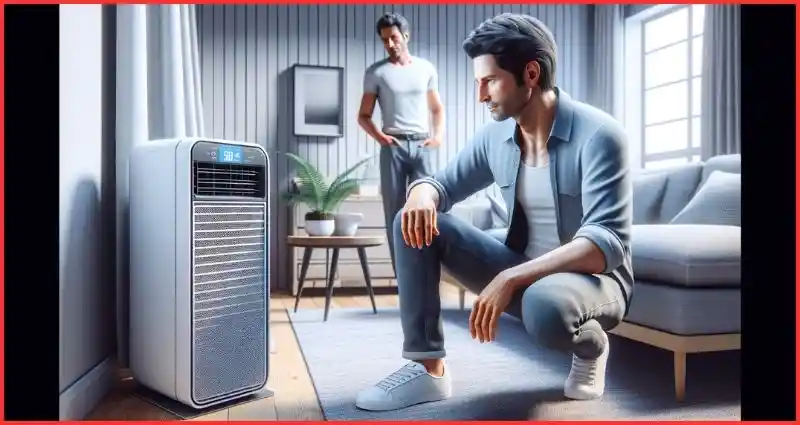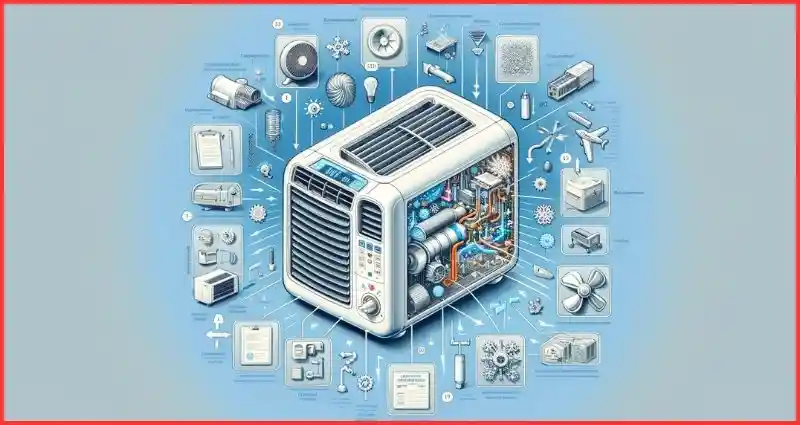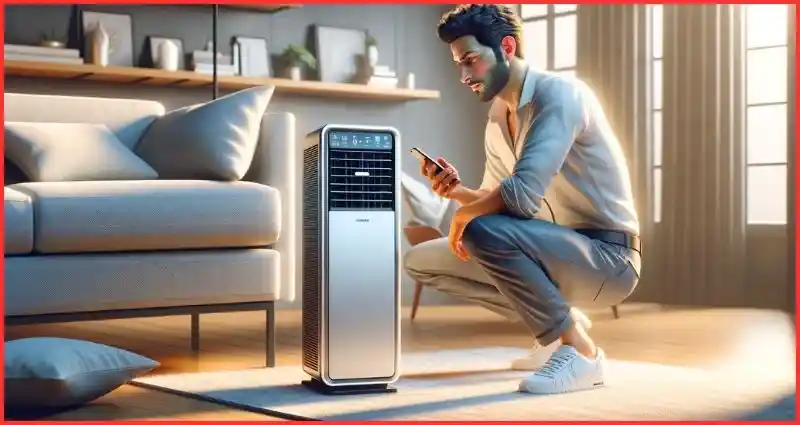A ventless portable air conditioner works by pulling in warm air, cooling it down using refrigerant, then releasing the cooled air back into the room. It doesn’t require an external vent or drainage system, making it a convenient cooling solution for small spaces.
Portable air conditioners are a popular choice for areas where traditional window units are not practical. These units work by operating a refrigeration cycle to remove heat and humidity from the air.
Ventless models use the moisture from the air to cool the unit’s condenser, allowing them to operate without needing a vent or drainage hose.
This makes them easy to set up and move around as needed. Understanding how a ventless portable air conditioner works can help you make an informed decision about your cooling needs.
Ventless Tech For Efficient Cooling

When it comes to portable air conditioning, ventless technology has revolutionized the way we cool our spaces.
Understanding the core principles of ventless air conditioning, as well as the key components involved in ventless AC operation, helps to shed light on the efficiency and environmental benefits of this innovative cooling solution.
Understanding The Core Principles Of Ventless Air Conditioning
Ventless air conditioners function by utilizing evaporation and condensation processes to cool the air without requiring a traditional exhaust vent.
This innovative technology allows for efficient cooling without the need for permanent installation or complicated setup.
Key Components Involved In Ventless Ac Operation
The main components of a ventless portable air conditioner include a compressor, evaporator, condenser, and a fan. These work together to circulate and cool the air, providing a consistent and comfortable indoor environment.
The Role Of Water And Evaporative Cooling
Ventless air conditioners make use of water for the evaporative cooling process, where warm air is drawn into the unit and passes over a wet filter or cooling pad.
As the air comes into contact with the water-saturated surface, heat is transferred to the water molecules, resulting in cooler air being circulated back into the space.
Environmental Benefits Over Traditional Ac Units
- Ventless portable air conditioners consume less energy, reducing overall electricity usage.
- They do not require an external exhaust vent, eliminating the need for complex installation and preservation of building structures.
- With no refrigerant emissions into the atmosphere, ventless air conditioners contribute to a more environmentally friendly cooling solution.
By leveraging the principles of evaporative cooling and eliminating the need for a traditional exhaust vent, ventless portable air conditioners offer an efficient and sustainable cooling alternative for various indoor spaces.
How Ventless Ac Units Function

Ventless portable air conditioners work by cooling and dehumidifying air within a space without the need for a traditional exhaust hose or vent.
These units are designed to be more flexible and easier to install than vented air conditioners, making them a popular choice for homes, offices, and other spaces where traditional cooling systems may not be feasible.
Understanding how ventless AC units function can help you decide if they are the right choice for your cooling needs.
Differentiating Ventless From Vented Air Conditioners
Unlike vented air conditioners, which require a window or other opening to exhaust hot air outside, ventless AC units utilize innovative self-evaporative technology to eliminate the need for a vent.
Instead of expelling hot air, these units use the evaporation process to cool the condenser and release moisture out of the exhaust hose, resulting in a more efficient and self-sustaining cooling process.
Detailed Walkthrough Of The Cooling Process
The cooling process in a ventless portable air conditioner begins with the air being drawn into the unit through the front intake. The air then passes through a series of filters to remove dust, debris, and other impurities before entering the cooling chamber.
Inside the cooling chamber, the air is cooled by a refrigerant and the excess moisture is collected and evaporated, allowing the cooled air to be recirculated back into the room.
Circulation And Room Air Dynamics
As the cooled air is circulated back into the room, it creates a consistent and comfortable environment. The ventless AC unit continues to draw warm air from the room, repeating the cooling process to maintain the desired temperature.
The air dynamics within the room are carefully managed to ensure that the entire space is effectively cooled and dehumidified, providing a more comfortable and energy-efficient cooling solution.
Portable Air Conditioner Anatomy

A ventless portable air conditioner works by utilizing the principles of evaporation and condensation to cool and dehumidify indoor air without the need for a permanent installation.
Understanding the anatomy of a portable air conditioner can provide insight into its functioning and how to maximize its efficiency and performance.
Core Parts: Evaporative Media, Reservoir, And Fans
The evaporative media is a critical component responsible for cooling the air. It consists of a porous material that facilitates the evaporation of water, leading to a reduction in temperature.
The reservoir holds the water that is utilized for evaporation, and it needs to be refilled occasionally. The fans play a crucial role in circulating the air through the evaporative media and distributing the cooled air throughout the room.
Exploring Controls And Settings For Optimal Use
Portable air conditioners are equipped with various controls and settings to adjust the cooling and airflow. The thermostat allows users to set the desired temperature, while the fan speed control enables customization of air circulation.
Additionally, timer settings can be programmed to conserve energy by turning the unit on or off at specific times.
Maintenance Tips For Longevity And Performance
Regular maintenance is essential to ensure the longevity and optimal performance of a ventless portable air conditioner. Cleaning the evaporative media and filters periodically prevents the accumulation of dirt and debris, which can hinder airflow and cooling efficiency.
The water reservoir should be cleaned to prevent the growth of mold or bacteria. It’s also important to check for any leaks or damage and address them promptly to avoid compromising the unit’s functionality
Implementing Your Ventless Device

Ideal Scenarios For Ventless Air Conditioner Usage
Ventless portable air conditioners are ideal for various scenarios where traditional AC units are not feasible. These may include small apartments, offices without proper ventilation, or areas that are not permissible for external venting.
The versatile nature of ventless ACs makes them a practical choice for spaces where traditional units are not an option.
Guidelines For Maximizing Cooling Efficiency
To maximize the cooling efficiency of your ventless air conditioner, ensure the unit is placed in a well-ventilated area for optimal air circulation. Avoid placing the unit near obstacles or in direct sunlight, as this can impede its performance.
Additionally, regular maintenance, such as cleaning or replacing filters, is crucial to uphold the unit’s cooling capacity.
Tips To Create Effective Airflow In Your Space
Creating effective airflow in your space is essential for the efficient operation of a ventless portable air conditioner. Consider utilizing fans to circulate air throughout the room, ensuring even distribution of cool air.
Avoid obstructing the unit’s airflow with furniture or other items, and maintain a clear pathway for air to flow freely. Additionally, keeping doors and windows closed while the AC is operating helps optimize its cooling potential.
Ultimate Guide To Ventless Ac Efficiency

A ventless portable air conditioner is a practical and energy-efficient cooling solution for spaces where traditional air conditioning units with ducts are not feasible.
These units are designed to provide efficient cooling without the need for permanent installation or external ventilation, making them an ideal option for apartments, dorm rooms, and other small living spaces.
Strategies For Energy-saving While Using The Unit
When it comes to maximizing the efficiency of a ventless portable air conditioner, there are several strategies that can help reduce energy consumption and lower operational costs. Consider implementing the following tips:
- Optimize Temperature Settings: Set the unit to the most comfortable temperature, typically between 72-78°F, to avoid excessive energy consumption.
- Utilize the Programmable Timer: Take advantage of the unit’s programmable timer feature to operate the air conditioner during peak cooling hours and reduce runtime when the space is unoccupied.
- Regular Maintenance: Keep the air filter clean and ensure the unit is free of dust and obstructions to maintain optimal performance.
Combining Ventless Ac With Other Cooling Methods
To enhance the cooling efficiency of a ventless portable air conditioner, consider incorporating other complementary cooling methods, such as:
- Ceiling Fans: Using ceiling fans in conjunction with the portable air conditioner can help distribute cool air throughout the room and maintain consistent comfort levels.
- Window Treatments: Install reflective window shades or blinds to minimize solar heat gain and reduce the workload on the air conditioner.
Understanding Limitations And Managing Expectations
While ventless portable air conditioners offer a convenient cooling solution, it’s important to understand their limitations and manage expectations. Consider the following factors:
- Cooling Capacity: Ventless AC units are best suited for smaller spaces, and may not provide sufficient cooling for larger rooms or open floor plans.
- Humidity Control: Unlike traditional air conditioners, ventless units may not dehumidify the air as effectively, especially in highly humid environments.
Frequently Asked Questions On How Does A Ventless Portable Air Conditioner Work?
How Do Portable Air Conditioners Work Without A Vent?
Portable air conditioners work by using a built-in water tank or tray to collect moisture. They then evaporate the collected water through the exhaust hose, which eliminates the need for a vent.
This process helps to cool down the surrounding air without requiring a traditional venting system.
Do Ductless Portable Air Conditioners Work?
Yes, ductless portable air conditioners work effectively to cool specific areas in homes or offices. They are easy to install and offer efficient cooling without the need for ductwork.
These units can be a cost-effective, energy-efficient option for cooling spaces.
Where Does The Heat Go On A Ventless Air Conditioner?
The heat from a ventless air conditioner is released into the room, lowering the temperature. It doesn’t need a vent because it doesn’t produce exhaust.
Can I Use A Portable Ac Without A Window?
Yes, you can use a portable AC without a window by using a venting kit or hose to expel hot air.
Conclusion
A ventless portable air conditioner operates by drawing warm air into the unit, passing it over cooling coils, and expelling the cooled air back into the room. This process facilitates the removal of heat and humidity, creating a comfortable indoor environment.
With its compact design and ease of installation, a ventless portable air conditioner offers a convenient cooling solution for various spaces, making it a popular choice for many consumers.


